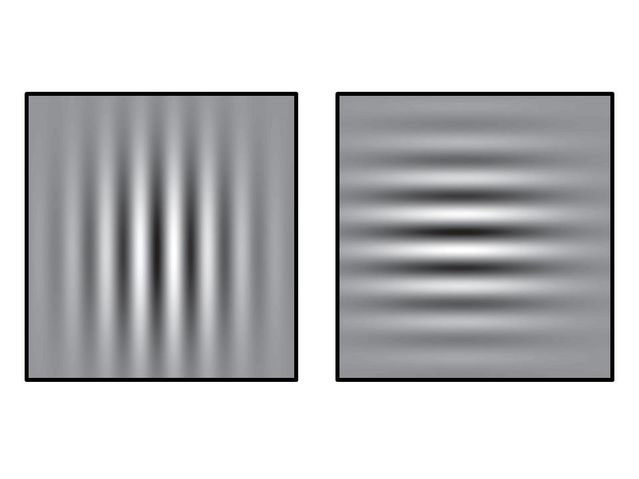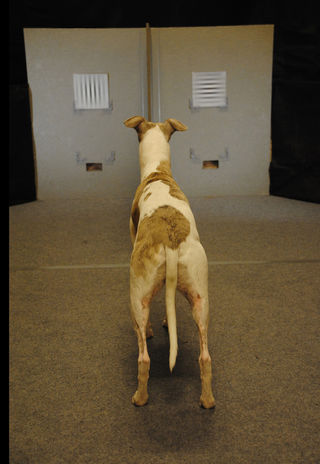Animal Behavior
Compared to Humans, How Good Is a Dog's Visual Acuity?
Humans have better visual acuity than dogs under most light conditions.
Posted December 14, 2017

If you are a human being, then your dominant sense is vision. That means that a person relies more upon visual inputs than any other form of sensory stimulation, and a larger portion of our brain is set aside to process visual information. For dogs, however, the dominant sense is smell, followed by their sense of hearing, with vision ranking third in importance. This is consistent with the fact that the dog brain has a relatively smaller number of neurons to process visual information. In addition, the dog's eye has many fewer cones — the sensory cells in the retina that provide the ability to see things in finer detail. These facts lead scientists to expect that the visual acuity of dogs will be less than the visual acuity of people. However, no studies have ever directly compared the vision of humans to the vision of dogs using the same exact stimuli and testing conditions, at least until now.
Recently a team of investigators working in the laboratory of Lina Roth at Linköping University in Sweden set out to evaluate the visual acuity of dogs and people using the same vision tests for both so that they could make a direct comparison. Also, since dogs are believed to have good vision in dim light, these researchers wanted to test how the vision of dogs and people varied under both bright and dimmer lighting conditions. These results were reported in the journal PLoS One.
When an ophthalmologist tests your vision, he or she typically presents you with a chart or shows you a slide of some sort, which contains alphabetic letters of different sizes. You are asked to read the letters and the smallest that you can accurately discriminate gives an estimate of how sharp your vision is. Obviously, asking a dog to read letters from a chart is not going to work. Therefore, these researchers decided to test the vision of dogs using a method called "grating acuity." In this case, this amounts to having a series of somewhat blurry black and white stripes which serve as the test stimuli. You can see an example of a pair of such test items below, one with the stripes presented vertically and the other with the stripes in a horizontal orientation.

The trick is that each dog is taught that one orientation of stripes (for example horizontal) is always associated with a reward. Thus if the dog sees a pair of images such these, and then picks out the correct one he would get a treat. As the stripes become more and more narrow, it becomes more difficult for the dog to see them clearly, and ultimately, when the stripes become thin enough, they appear to blur to gray. The narrowest stripe width where a dog can discriminate the horizontal from the vertical, gives a measure of the dog's visual acuity in a measurement unit called cycles per degree (where each cycle is simply a dark and a light band). You can see a dog in the test apparatus below.

These researchers not only varied how narrow the stripes were but also how bright or dim the lighting conditions were. It is well-known that as the light becomes dimmer visual acuity becomes poorer.
One nice thing about using this kind of testing situation is that human beings can also be tested using exactly the same kind of visual test patterns. (Of course, there is no necessity to give the humans a treat every time they give a correct answer.) However, since the humans and the canines were being tested using the same test items and lighting conditions, it is possible to make a direct comparison as to what the relative visual acuity is for dogs and people.
When tested under bright light conditions human beings in this study were able to distinguish patterns, on average, up to approximately 40 cycles per degree, while dogs were only able to distinguish patterns which had considerably wider stripes, for an average of 12 cycles per degree.
It may be a bit difficult to understand what this level of visual acuity difference represents, so perhaps we should convert them to the more familiar measures that are typically used by medical people when they are testing you. They use something which is called the Snellen ratio because it is based on an eye chart which was originally designed by a Dutch ophthalmologist named Herman Snellen.
In this measure, the actual number assigned as a measure of your acuity is based on how well your test performance compares to a person known to have normal visual acuity. If you are tested at a distance of 20 feet and can accurately read the same line of letters that a person with a normal vision can read at 20 feet then the Snellen measure of your vision is 20/20 (or 6/6 if you are measuring the distance in meters). If your vision is not that good then you will need letters which are larger to read them at that distance. Thus, if the letters that you can just barely read correctly at 20 feet are large enough for a person with normal vision to read at 40 feet then your vision is 20/40 (or 6/12 in metric). A person with 20/40 vision is considered to have noticeably impaired vision and such a person would be required to wear glasses when driving a car in almost all of North America. The big E at the top of the eye chart corresponds to a Snellen acuity of 20/200 meaning that a person with normal vision can read it at 200 feet.
When the measures obtained in this recent investigation are converted into the more commonplace Snellen measures, we find that the humans in this particular test actually come out a little bit better than normal with an average visual acuity of approximately 20/15. (The reason that they are a bit better than 20/20 is that the testing conditions in this experiment involve a light level which is brighter than is normally used in clinical testing and brighter light tends to give better acuity measures, at least up to the point where glare becomes a problem). For the dogs, their acuity is 20/50, which would be noticeably impaired and obviously would require your dog to wear glasses if you let him drive.
The vision of both dogs and people deteriorates under conditions where the light is dim. Now the humans can only discriminate wider stripes with the minimum being eight cycles per degree on average. This corresponds to a Snellen measure of about 20/75. This is relatively low acuity, but the dim light used in this test situation caused the test stimuli to be pretty dark. For dogs, under these circumstances, their vision deteriorated to an average of 2.5 cycles per degree, which corresponds to a Snellen measure of 20/250. Remember the big E on the eye chart corresponds to 20/200, which means that the dogs would not be able to reliably discriminate even that letter in at the dim light levels used in this study.
So, obviously, the visual acuity of people is considerably better than the visual acuity of dogs under all of the lighting conditions tested. But how would we describe the magnitude of this difference in the visual acuity of humans and canines? Well, this current team of Swedish researchers has done that for us. They looked back over the totality of their findings and came up with the following conclusion: "Roughly, on average, the visual acuity of humans is three times higher than in dogs in both bright and dim conditions."
Copyright SC Psychological Enterprises Ltd. May not be reprinted or reposted without permission.
References
Lind O, Milton I, Andersson E, Jensen P, Roth LSV (2017) High visual acuity revealed in dogs. PLoS ONE 12(12): e0188557. https://doi.org/10.1371/journal.pone.0188557




